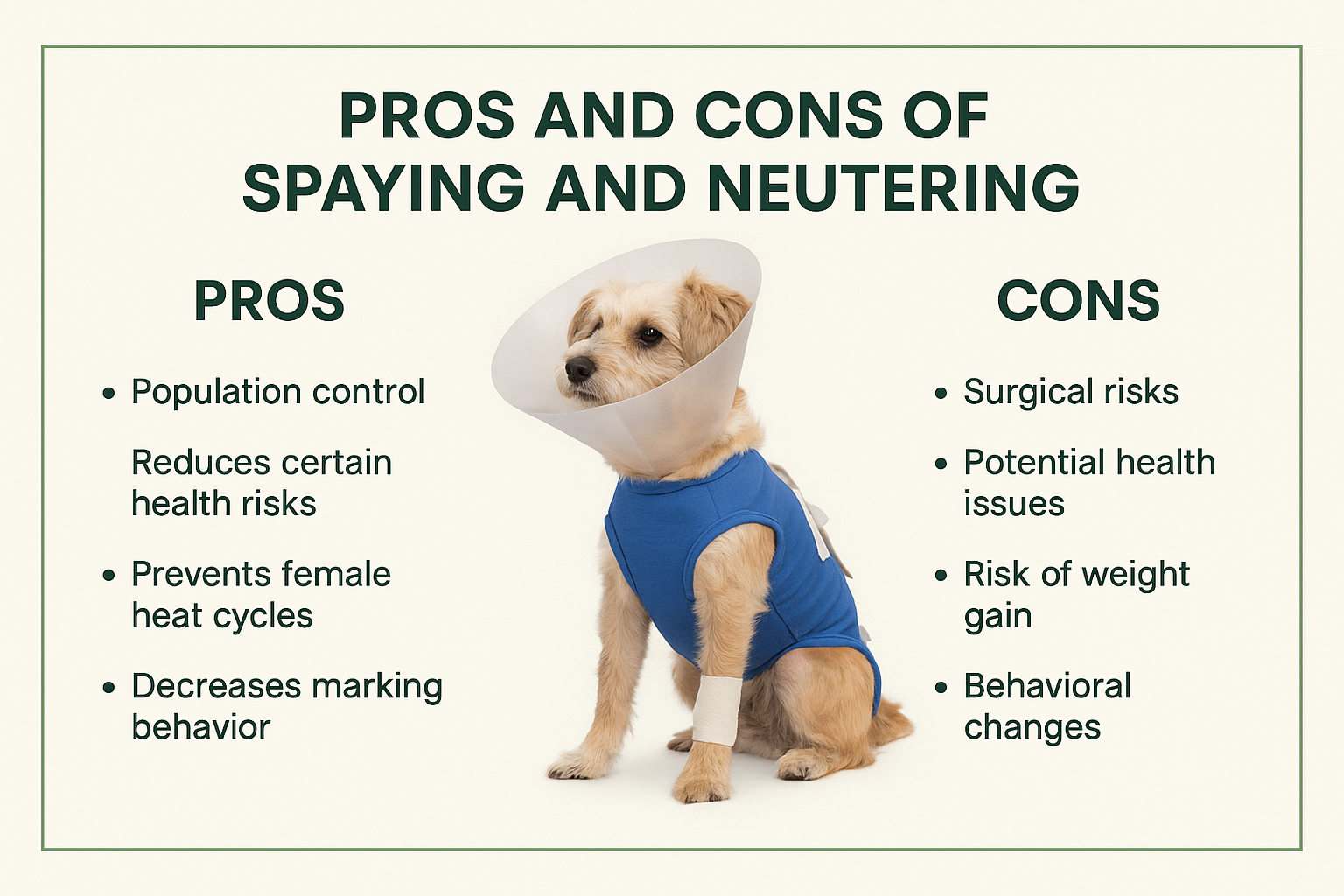Spaying & Neutering Small Dogs: Pros, Cons, Costs, and What to Expect
By Ashley MR · 5 minute read
Last updated: September 4th, 2025

Owning a small dog comes with big decisions—one of the most important being whether to spay or neuter your pup. While these surgeries are common, many owners have questions about timing, health risks, behavior changes, and costs. This guide breaks down everything you need to know about spaying and neutering small breed dogs, so you can make an informed choice.
What Is Spaying and Neutering?
Spaying: Surgical removal of a female dog’s ovaries and uterus.
Neutering: Surgical removal of a male dog’s testicles.
Both prevent unwanted pregnancies, but they also have health and behavioral effects worth considering.
When Should Small Dogs Be Spayed or Neutered?
Small breeds mature faster than large dogs, so vets often recommend surgery between 6–9 months of age. Some veterinarians may suggest waiting until closer to one year to allow for full growth and joint development. The American Veterinary Medical Association recommends talking with your vet about your dog’s breed, size, and overall health before deciding.
Pros of Spaying and Neutering Small Dogs
Health benefits
Females: Reduced risk of pyometra (uterine infection) and mammary cancer.
Males: Lower risk of testicular cancer and some prostate diseases.
Behavioral improvements
Reduced roaming and aggression in males.
Decreased marking and urine spraying.
Easier potty training
Neutered males are less likely to lift their leg and mark in the house.
Population control
Prevents unwanted litters, which can be risky for small breeds.
Cons and Risks of Spaying and Neutering
Surgical risks: As with any anesthesia, small dogs are at slightly higher risk of complications due to their size.
Weight gain: Hormonal changes may slow metabolism—diet and exercise are key.
Joint concerns: Early spaying/neutering (before growth plates close) may increase the risk of orthopedic issues.
Behavioral changes: Some dogs may become more timid or lose certain protective instincts.
Female Heat Cycles: What Owners Should Know
If you choose not to spay:
Small females typically enter their first heat cycle between 6–10 months.
A heat lasts about 2–3 weeks, twice per year.
Signs include vulvar swelling, bloody discharge, frequent urination, and attracting male dogs.
How to prepare:
Use doggy diapers or washable pads indoors.
Keep your female away from intact males.
Expect mood and behavior changes, including clinginess or irritability.
The Risks of Breeding Small Dogs
Small breeds often struggle with pregnancy and delivery. Many require C-sections due to narrow birth canals and large puppy heads (common in breeds like French Bulldogs, Chihuahuas, and Pomeranians). Pet MD states, C-sections can cost $2,000–$5,000, making breeding financially and medically risky for your pet.
Cost of Spaying & Neutering Small Dogs
Spay (female): $200–$600 (higher due to complexity)
Neuter (male): $100–$400
Factors affecting price:
Location and clinic type (private vet vs. low-cost clinic)
Dog’s weight (smaller dogs often cost less)
Additional services (pain meds, bloodwork, overnight stay)
Pet insurance: Some plans cover spay/neuter under wellness packages. Check providers like Fetch who offer tailored plans to suit your needs.
Behavioral Impacts in Small Dogs
Marking and potty training: Neutered males are less likely to mark; intact males may struggle with housetraining.
Socialization: Altered dogs may be viewed differently by other dogs; intact males can show dominance or aggression toward each other.
Energy and play: Many owners report calmer behavior after surgery, though personality remains the same.
Pros & Cons at a Glance
| Benefits | Risks/Drawbacks |
|---|---|
| Prevents unwanted litters | Surgical/anesthesia risks (higher in tiny breeds) |
| Reduces cancer risks | Potential for weight gain |
| Helps with potty training and marking | Possible orthopedic concerns if done too early |
| Can improve social behavior | Some personality/behavioral changes |
| Prevents costly, risky pregnancies | Expense of surgery |
FAQ
Should I wait until my small dog has her first heat to spay her?
Most vets recommend spaying before the first heat to reduce cancer risk, but waiting may lower orthopedic risks. Discuss timing with your vet.
Will neutering stop my male dog from marking?
It reduces marking in many dogs, especially if done before the habit is established. Training is still key.
Is breeding small dogs dangerous?
Yes—many small breeds are prone to complications and may require expensive C-sections. Breeding should only be considered with veterinary guidance.
Conclusion
Spaying or neutering is a personal decision, but for most small dog owners, it brings long-term health, behavior, and financial benefits. By understanding the pros and cons, preparing for heat cycles if you delay, and weighing the costs and risks of breeding, you can make the best choice for your pup’s future.
If you’re exploring whether spaying or neutering is right for your small dog, talk with your veterinarian and compare options for cost, timing, and pet insurance coverage. An informed choice today can mean a healthier, happier life for your companion tomorrow.
👉 Looking for your perfect puppy? Explore Mawoo Pets puppies for sale and learn more about your favorite breeds.
Related articles
Related puppies for sale
Any questions? Get in touch!
We are here to support you every step of the way. Our concierge service is here daily to answer your questions!
Chat or speak with our team Mon-Sat 9a-9p ET.





























